One of the most well known facts about birds is that they migrate, or fly south in the winter. However, not all birds migrate. Even in cold climates, some birds stick around in winter. In fact, winter is the most popular time to put up bird feeders because birds are more likely to visit feeders when there is less food in their natural habitat. Here are 25 birds you might see in winter in upstate New York.
1. American Crow

American Crows communicate with short, rhythmic caws that can be used to identify them.
©jpetersen/Shutterstock.com
The American crow is a common species that is widespread throughout North America. These birds prefer to live in open areas and are often found near water or in areas inhabited by humans. They are found throughout the state of New York but are especially common in the central and western parts of the state. Crows are members of the corvid family, a group of birds known for their intelligence. Like most corvids, crows are omnivores and eat a wide variety of foods. They may visit feeders for foods such as sunflower seeds, safflower seeds, and peanuts, but they aren’t always welcome visitors at feeders since they’re larger birds that eat a lot and may be aggressive towards smaller birds.
2. American Goldfinch

Winter American goldfinches are drab, unstreaked brown, with blackish wings and two pale wing bars.
©iStock.com/Ronald Washington
The American goldfinch sticks around in winter, but may be harder to identify then. Goldfinches are known for their bright yellow plumage, but when the breeding season is over, they change to a dull brownish yellow. American goldfinches live in areas with scattered trees or shrubs. They mainly eat seeds, and will visit feeders for sunflower seeds and black thistle (also called Nijer). Goldfinches living farther north actually do fly south in the winter, but the New York population stays there year round.
3. American Tree Sparrow
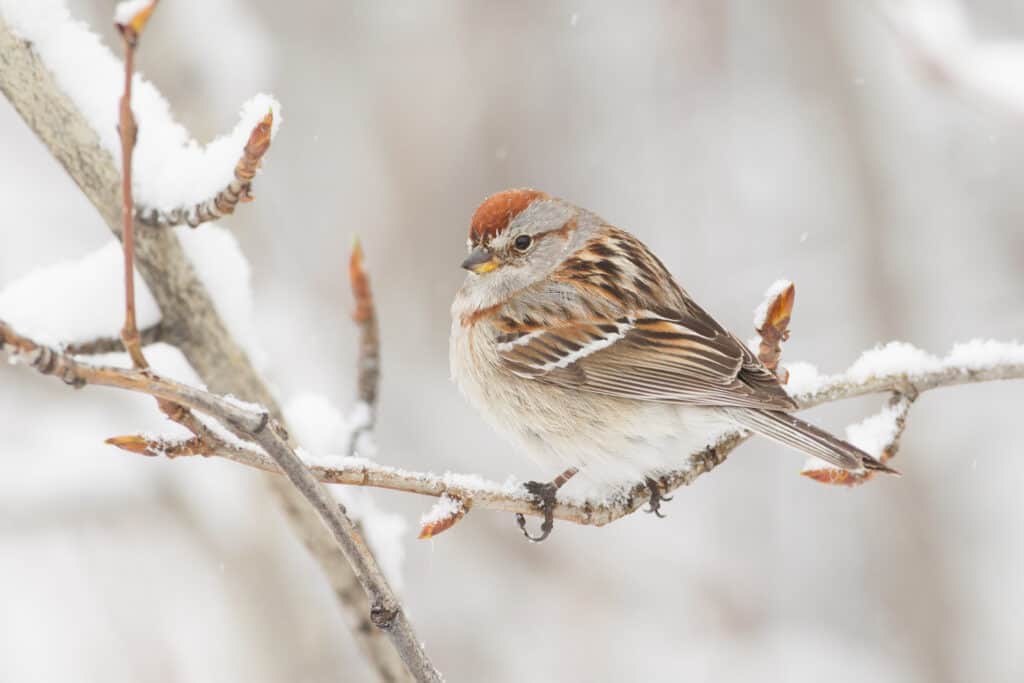
The American tree sparrow spends summers in northern Canada and winters across the U.S.
©Jukka Jantunen/Shutterstock.com
The American tree sparrow is one of the few birds that is more common in New York in the winter. Most American tree sparrows spend the summer breeding season in northern Canada. In winter, they migrate south to locations across the United States, including New York. American tree sparrows mostly eat seeds, though they will also eat some insects and berries. They regularly visit feeders for seeds, especially sunflower and safflower seeds.
4. Barn Owl

Barn owls are easily recognizable by their white, heart-shaped faces.
©iStock.com/mzphoto11
The barn owl is one of the most common types of owls in New York. Barn owls can be found in a variety of habitats, and they often nest in manmade structures such as old barns, which is where they get their name. Like all owls, barn owls are carnivores. They eat small mammals, primarily rodents. They hunt their prey at night, usually in open areas such as fields. Because of their carnivorous diet, barn owls will not visit feeders, but some people attract them by putting up nest boxes.
5. Barred Owl

Barred owls are named after the bars of different colors on their feathers.
©FotoRequest/Shutterstock.com
Another type of owl commonly found in New York is the barred owl. These owls primarily live in the eastern United States, though there are some parts of the country where they range farther west. They prefer to live in mature mixed forests and swamps. Like barn owls, barred owls are carnivores that eat rodents and other small mammals, which they hunt primarily at night. They can be hard to spot, but you might have better luck listening for them. The barred owl has a distinctive call which is often described as sounding like the phrase “Who cooks for you? Who cooks for you all?”
6. Black-capped Chickadee
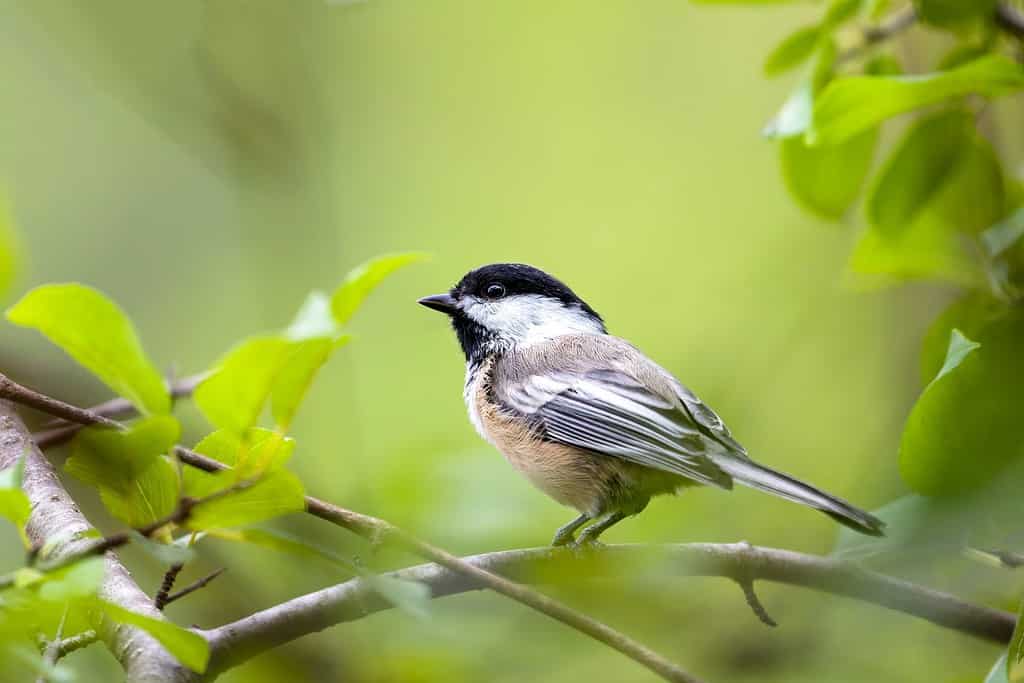
Black-capped chickadees are named for the black “caps” on their heads.
©Manu M Nair/Shutterstock.com
The black-capped chickadee is the bird you’re most likely to see at a bird feeder in New York in winter. They can be found throughout the state but prefer to live in mixed woodland. Black-capped chickadees are omnivores and eat insects and spiders as well as seeds and berries. At feeders, they will eat suet, sunflower seeds, peanuts, and peanut butter. They easily become accustomed to human presence and may even eat out of the hand of a patient person.
7. Blue Jay

Blue Jays are adaptable and intelligent birds.
©FotoRequest/Shutterstock.com
The blue jay is a common bird species found throughout North America. These birds are known for their distinctive call that sounds like the word “jay,” but they actually make a variety of calls, including some that imitate the calls of birds of prey. Like crows, blue jays are members of the corvid family, and like other corvids, they are omnivores that eat a wide variety of foods. At feeders, their favorite food is unshelled peanuts, but they will also eat sunflower seeds, safflower seeds, and suet.
8. Canada Goose
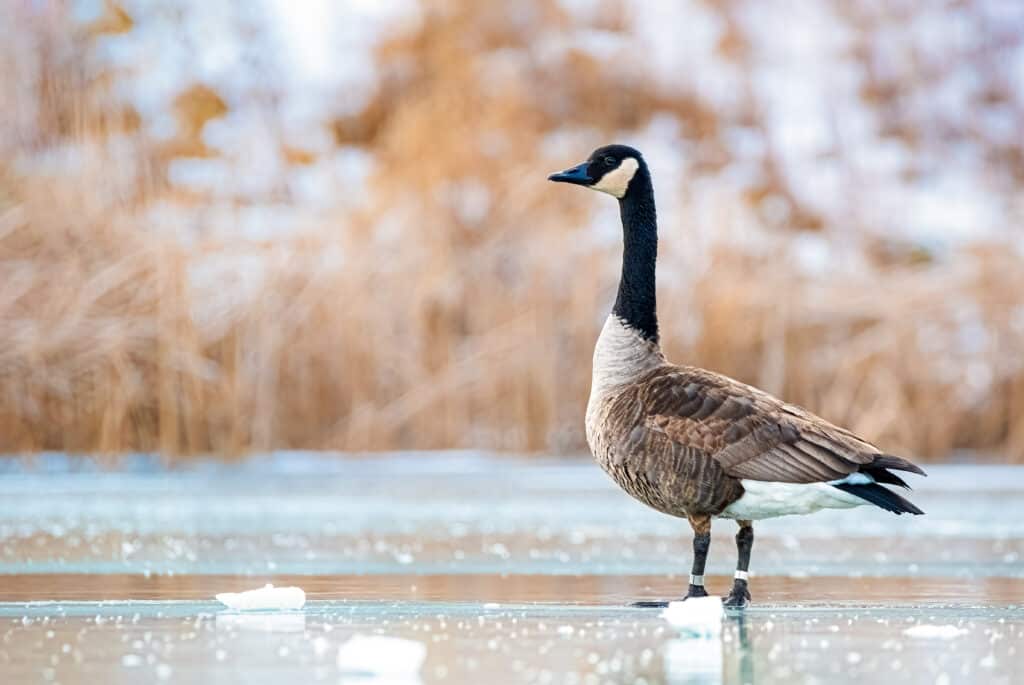
Canada geese are recognizable by their black necks and white throats.
©Rogney Piedra Arencibia/Shutterstock.com
The Canada goose is a well known migratory bird, and many people have observed them flying south in their distinctive V-shaped formation. However, not all Canada geese migrate. In a portion of their range which includes New York, some Canada geese will stick around during winter. This has become increasingly common due to human changes to the environment. Canada geese are widespread throughout the United States and prefer to live in open areas and wetlands.
9. Carolina Wren

Carolina wrens are small birds with long beaks.
©Steve Byland/Shutterstock.com
The Carolina wren is found throughout the eastern and central parts of the United States. These birds live in woodlands as well as suburban areas. They primarily eat insects, but they will also eat some seeds and berries. Carolina wrens will also visit feeders, where their favorite foods are sunflower seeds, suet, peanut butter, and mealworms.
10. Dark-eyed Junco
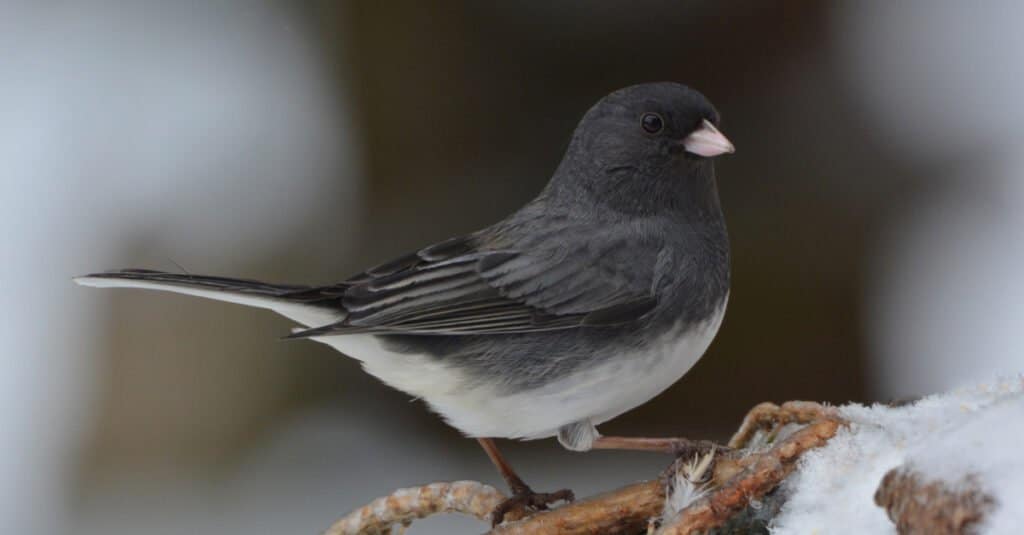
The female Dark-Eyed Junco has more muted coloring than the male.
©C. Hamilton/Shutterstock.com
The dark-eyed junco is a unique bird that varies in color based on its region of origin. Those found on the east coast, including New York, are slate-colored. Dark-eyed juncos live in open woodland and brushy areas. In New York, they are especially common near the Hudson River. They eat seeds and insects. They are also common visitors to feeders, where they like to eat hulled sunflower seeds, millet, black thistle, peanuts, and cracked corn.
11. Downy Woodpecker

Like other woodpeckers, downy woodpeckers hunt insects by drilling holes in trees.
©J Edwards Photography/Shutterstock.com
The downy woodpecker is the smallest woodpecker in North America, and one of the most common. Downy woodpeckers prefer to live in deciduous and mixed woodland, but they can also be found in suburban backyards and even urban parks. In the wild, these birds eat insects, seeds, and berries, but they are also fairly common visitors at feeders, where they will eat sunflower seeds, millet, peanuts, and suet.
12. European Starling
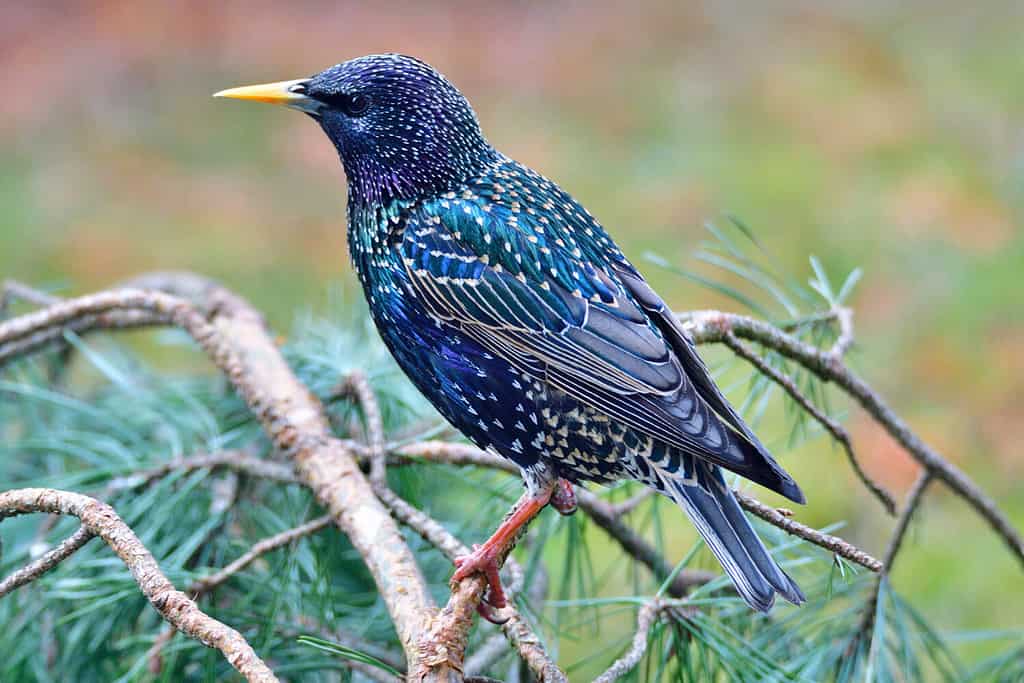
European starlings have glossy black feathers that gain white spots in winter.
©Karin Jaehne/Shutterstock.com
The European starling is one of the most common non-native bird species in the United States, being native to Europe. In the 1890s, 100 European starlings were intentionally released in Central Park, and they have since become widespread across the U.S. European starlings prefer to live in open areas, and they are especially common in towns and cities. In winter, their plumage is a little different, as they gain white spots on their black feathers. Look for them flying and foraging together in large flocks.
13. Hairy Woodpecker
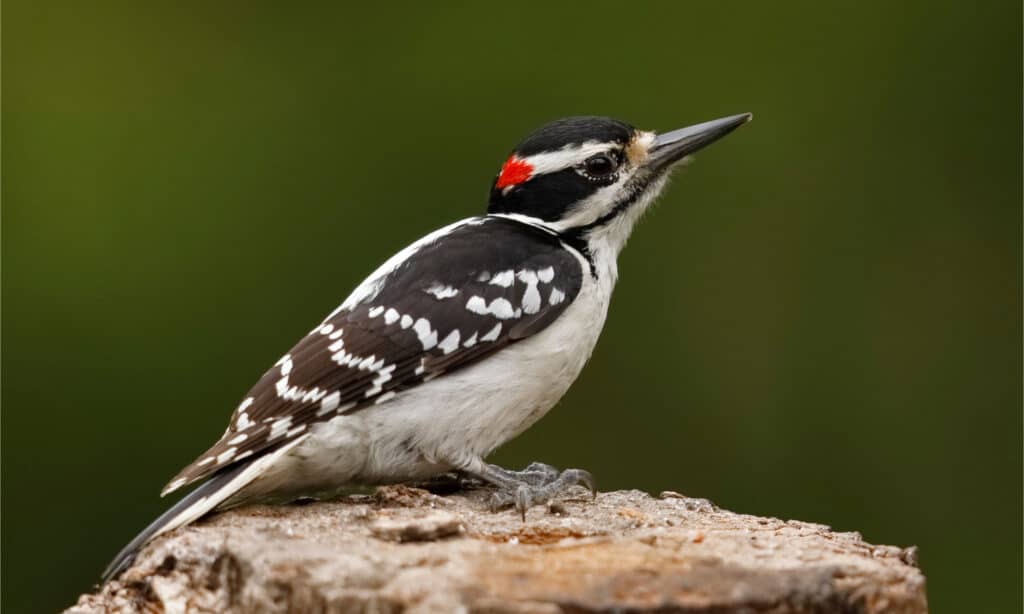
Hairy woodpeckers have square heads and long bills.
©Brian Lasenby/Shutterstock.com
The hairy woodpecker is a common bird to see at feeders in the winter. These woodpeckers primarily live in mixed deciduous and hardwood forests throughout the eastern and central United States. Hairy woodpeckers eat mainly insects, but they will also eat fruit and seeds. At feeders, they will eat sunflower seeds, suet, and peanut butter.
14. Herring Gull
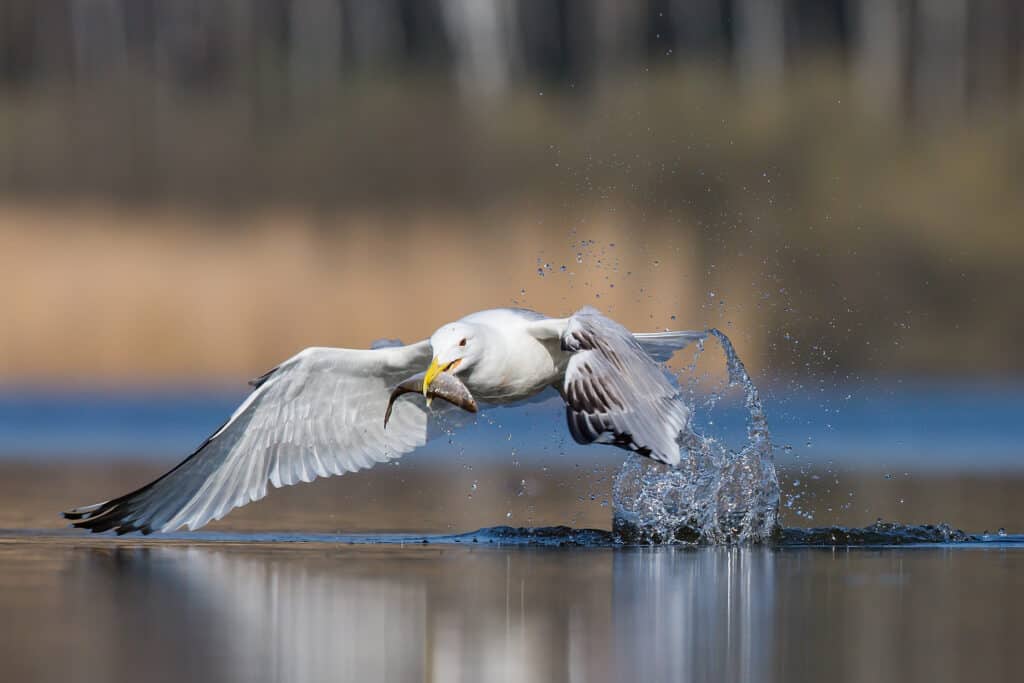
Herring gulls are mostly white with gray wings.
©Lukas Pavlacik/Shutterstock.com
The herring gull is the species most east coast residents picture when they think of seagulls. While some herring gulls migrate in winter, others, including those on the Atlantic coast and around the Great Lakes, stay in their home range year round. Herring gulls migrating from Canada may also spend the winter in New York. Herring gulls live in open areas, especially near water. They are opportunistic feeders that eat marine invertebrates, fish, insects, earthworms, and smaller birds, as well as carrion and human food or trash.
15. House Finch
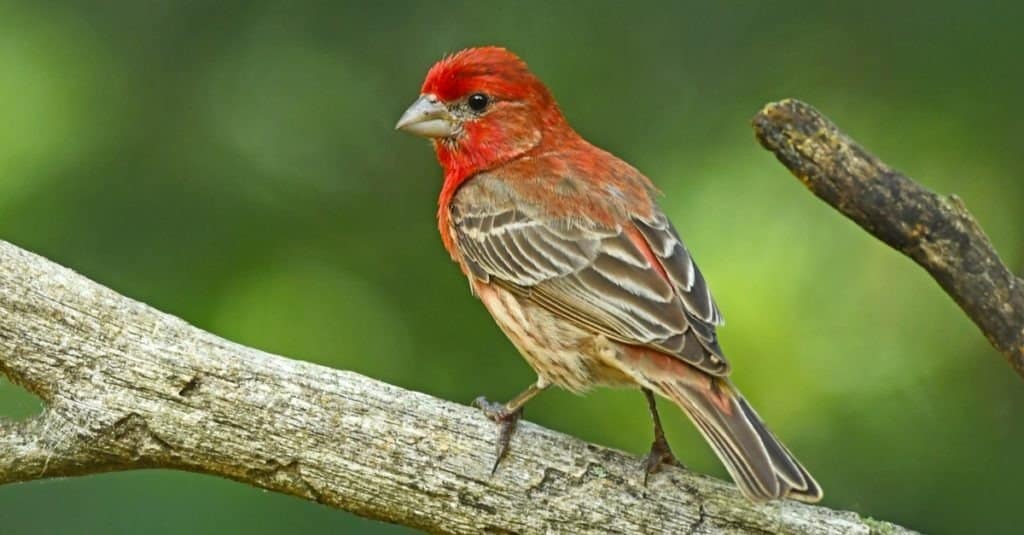
Male house finches have red heads and chests.
©Brian A Wolf/Shutterstock.com
The house finch is native to the western parts of the United States and Mexico. In 1940, some house finches were released on Long Island, New York, after failed attempts to sell them as pets. Now, they are widespread across the United States. House finches live in a wide variety of habitats, including open woodland, brushy fields, deserts, and suburban areas. They are primarily herbivores, eating seeds, buds, and fruit. They will also visit feeders, especially for black oil sunflower seeds.
16. House Sparrow
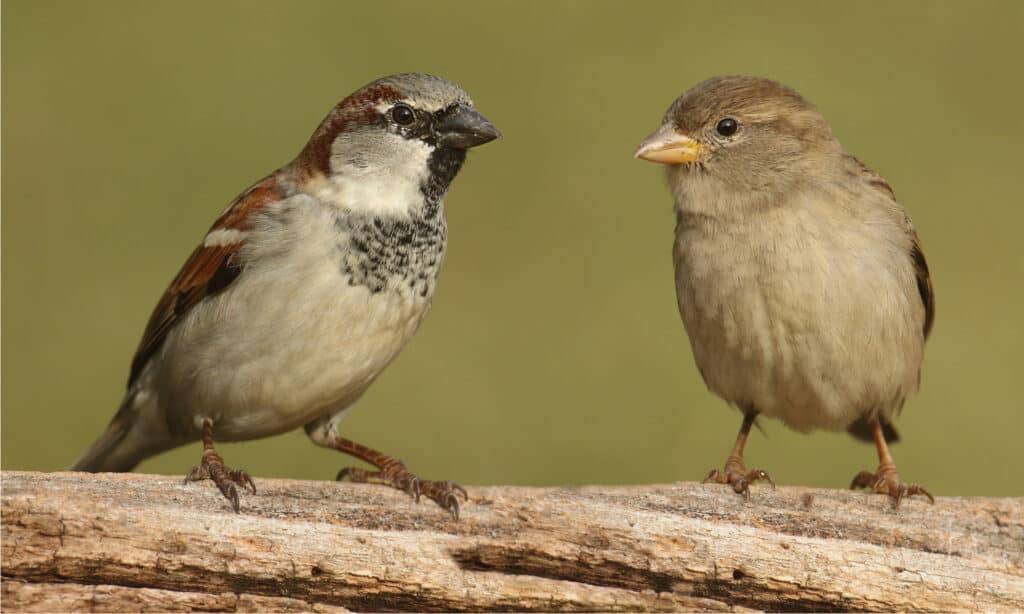
Male and female house sparrows are both brown but have different markings.
©Steve Byland/Shutterstock.com
The house sparrow is another non-native species that has become widespread in North America. These birds are native to England and were introduced intentionally in 1851 as a misguided attempt to control insect pests on crops. House sparrows are highly adaptable and often prefer to live in areas inhabited by humans, such as cities and towns. They nest in cavities such as tree holes, birdhouses, and buildings. House sparrows primarily eat seeds but will also eat some insects and fruit. They will visit feeders, but they may be unwelcome visitors due to their non-native status.
17. Mourning Dove
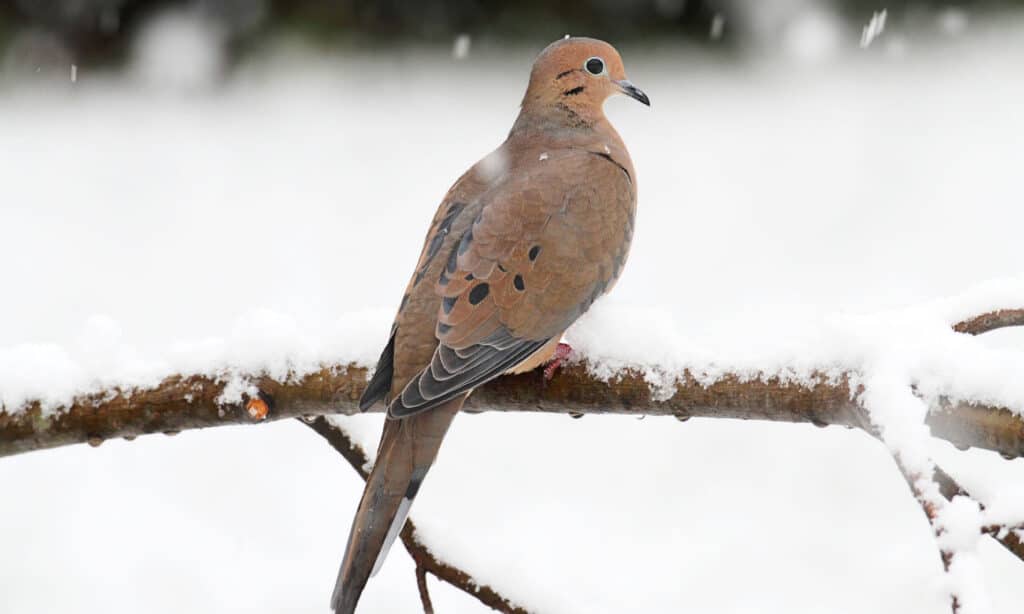
Mourning doves are easily recognized by the sound of their cooing.
©iStock.com/SteveByland
The mourning dove is a species of dove that is widespread throughout North America. These doves live in a wide variety of habitats, but they tend to prefer open areas. Mourning doves mainly eat seeds, plants, and berries, though they will occasionally eat small creatures such as insects. They also visit feeders where they will eat a variety of foods, including shelled sunflower seeds, thistle, cracked corn, peanuts, and millet. They tend to prefer eating on flat surfaces instead of clinging to a feeder, so consider putting up a tray feeder or scattering seeds on the ground if you want to attract them.
18. Northern Cardinal

Only male northern cardinals have the iconic red plumage. Females are brown with red markings.
©iStock.com/Hongkun Wang
The northern cardinal is probably the most iconic winter bird in much of the United States. Northern cardinals are found throughout eastern North America, where they prefer to live around the edges of woods. They eat fruit, seeds, and insects. They are also common visitors to feeders, where they will eat sunflower seeds, safflower seeds, peanuts, millet, and milo.
19. Pileated Woodpecker
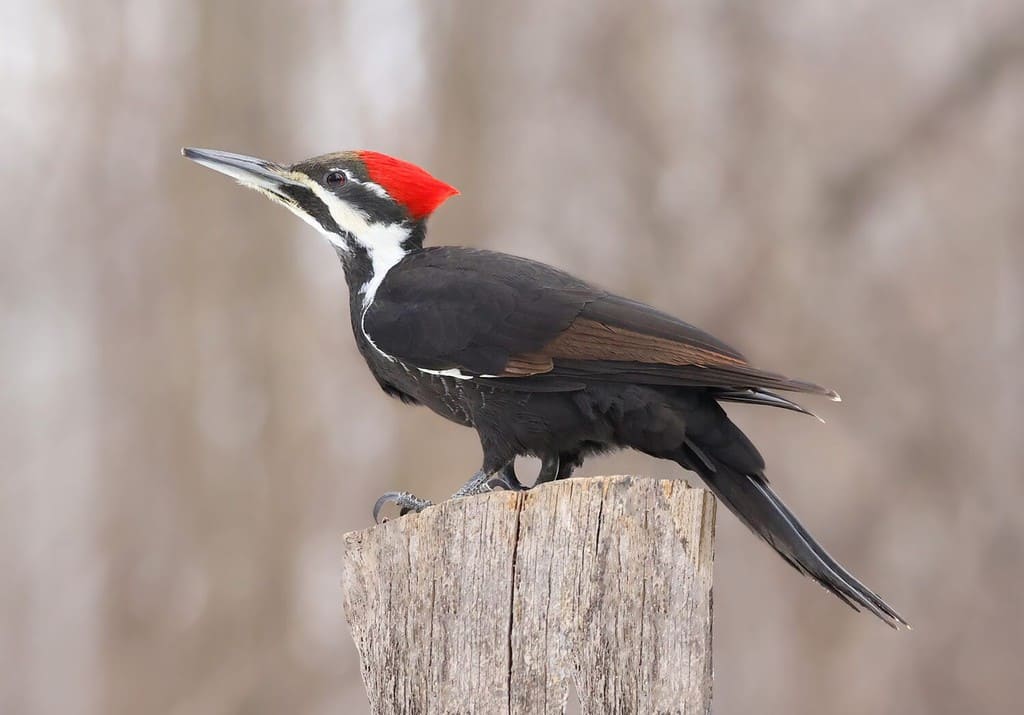
Pileated woodpeckers have distinctive red crests.
©Vlad G/Shutterstock.com
The pileated woodpecker is the largest woodpecker in North America, and one of the most iconic. If you live in a town or city, you’re less likely to see a pileated woodpecker than some of the other birds on this list, because they prefer to live in mature forests with large trees. Pileated woodpeckers primarily eat insects, which they find by drilling holes in dead trees with their beaks. Because of their more remote habitat and largely insectivorous diet, they don’t visit feeders often, but they will occasionally eat suet from feeders.
20. Purple Finch

Seeds are a primary food source for purple finches.
©Aaron J Hill/Shutterstock.com
The purple finch is an easy bird to recognize due to the male’s iconic raspberry red plumage. Purple finches eat seeds, buds, nectar, and fruit, as well as some insects. They also visit feeders, where their favorite food is sunflower seeds. Purple finches are partial migrants, meaning they will migrate some years but not others. When food is scarce, they migrate in search of a food source, but when the local trees produce plenty of seeds for them to eat, they’ll stick around in winter.
21. Red-bellied Woodpecker

As confusing as the red head may be, the red-bellied woodpecker does, in fact, have a red belly.
©rck_953/Shutterstock.com
The red-bellied woodpecker is a common species of woodpecker found throughout the eastern United States. These woodpeckers live in a variety of habitats including open areas, mixed forests, and suburban and rural areas. They eat insects, spiders, fruits, nuts, and seeds. They also eat suet from feeders. Like many woodpeckers, red-bellied woodpeckers nest in tree holes which they drill themselves.
22. Red-breasted Nuthatch
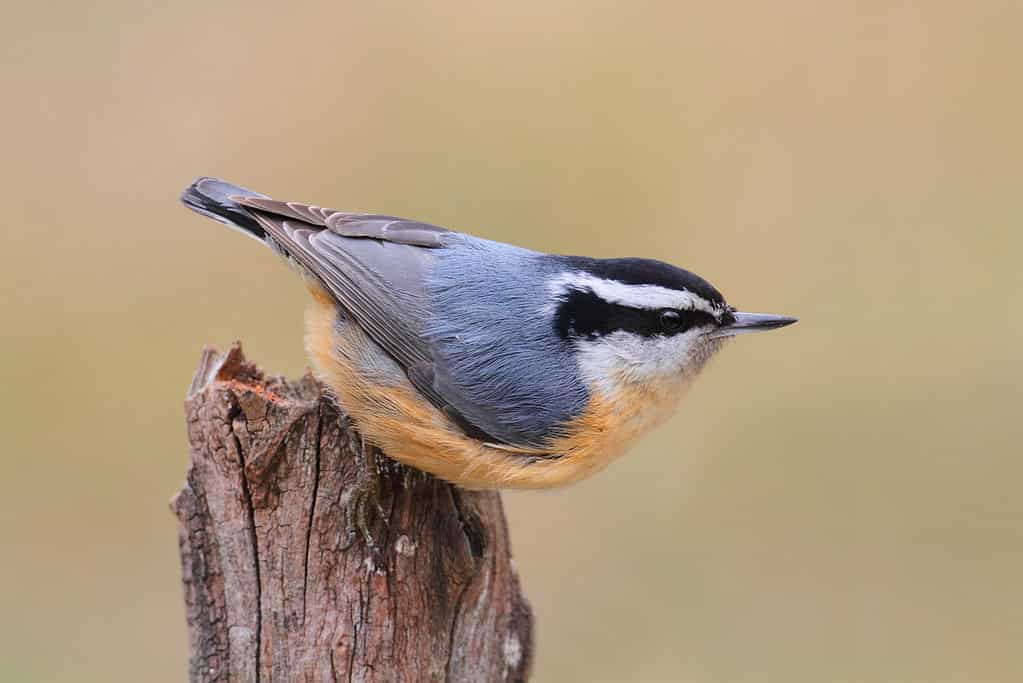
Red-breasted nuthatches can often be seen clinging to tree bark.
©iStock.com/SteveByland
The red-breasted nuthatch is primarily found in conifer forests and mixed forests. In summer, red-breasted nuthatches mainly eat insects, but in winter, they switch to relying on seeds. They also visit feeders where they will eat sunflower seeds and suet. Like purple finches, red-breasted nuthatches are partial migrants, only migrating in years when food is scarce.
23. Tufted Titmouse

The tufted titmouse is gray with a white breast, red sides, and a crest.
©Brian A Wolf/Shutterstock.com
The tufted titmouse is another of the most common feeder birds in New York in winter. Tufted titmice live in deciduous forests, open woodland and forest edges. They often form flocks with other types of birds including chickadees, woodpeckers, and nuthatches. In the wild, they eat seeds and insects, while at feeders, they eat sunflower seeds, peanuts, and suet.
24. White-breasted Nuthatch

The white-breasted nuthatch looks similar to the red-breasted nuthatch but has no red coloration.
©Jim Nelson/Shutterstock.com
The white-breasted nuthatch is a common bird throughout the eastern United States and can be found in a variety of habitats. In New York, these birds are especially common in the Adirondack and Catskill Mountains. White-breasted nuthatches eat insects, seeds, and fruit. They are also common visitors to feeders, where they eat sunflower seeds, peanuts, and suet.
25. White-throated Sparrow

White-throated sparrows can be distinguished from other sparrows by their facial markings.
©Fiona M. Donnelly/Shutterstock.com
The white-throated sparrow is a common species throughout North America. Like the American tree sparrow, most white-throated sparrows spend the breeding season in Canada. In winter, they migrate to locations across the United States, including New York, so they’re more common in New York in winter. White-throated sparrows eat insects, seeds, and berries. They are also common visitors to feeders, where they eat sunflower seeds, safflower seeds, thistle, cracked corn, and millet.
The photo featured at the top of this post is © Walter Coate/Shutterstock.com
Thank you for reading! Have some feedback for us? Contact the AZ Animals editorial team.






